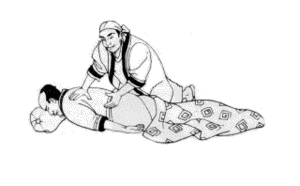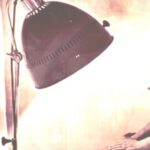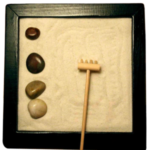I hear the term ‘shiatsu’ misused a lot. It seems to have somewhat of a pleasant marketing advantage-it evokes imagery and a sense of things Asian, exotic, and zen. I have seen electric chair massage cushions called ‘shiatsu massagers’, lotions called ‘shiatsu spa cream’, and even backscratchers with little roller beads, called “shiatsu pressure rollers.” And unless that backscratcher is going to put its knees on the back of your hamstrings whilst tractioning your sacrum with its palms, I think it is okay to assume the term ‘shiatsu’ is being used at best, gratuitously, or ignorantly, and at worst, deceptively.
So, what is shiatsu? Its literal meaning is ‘finger pressure’, but that is misleading. Here is a good description that I wrote for a spa menu:
Shiatsu is an ancient Japanese bodywork modality that is performed on a comfortable futon, while the client remains fully clothed. Finger, hand, elbow, knee, and foot pressure are strategically used along the client’s “meridians,” or energetic pathways, with the intent of releasing blockages and moving stagnant “ki,” or energetic life-force. Deep stretches are also employed. Although shiatsu is by nature very deep bodywork, less pressure can be used to suit the client’s preferences.
From this description, you get a sense that a typical shiatsu session is quite different than what even seasoned spa-goers are used to. Although it is usually classified as a massage, It differs from a regular, Swedish massage in many ways. For one, it is usually a bit more expensive than a regular massage. And then there are the differences of the bodily positions, the strokes, products, and techniques used, and of course, the actual dynamics and intention of the bodywork is different in shiatsu than in regular massage.
What does it feel like, and what are its effects? The effects are two fold. There is a sense of energy work at play, since the physically invisible meridians are manipulated, affecting the ki. The intent and effect of manipulating specific energetic places along the meridians, also referred to as ‘acupressure points’, ‘pressure points’, or ‘tsubos’, can have a similar or same effect as acupuncture or acupressure therapy. In acupuncture, needles are placed in the points, and in acupressure, a firm or light touch is used on the points. These techniques stimulate the points, and in turn, the meridians, creating a mild injury, which brings about a healing response to the given area. Whereas in shiatsu, the points and meridians are manipulated with firm pressure and bodywork techniques and manipulations like stretches and tractioning. Aside from the energy work aspect, shiatsu provides a deep direct physical therapy, also. Although acupuncture, acupressure, and shiatsu are based on the same principles, the therapies provide a different acute effect. The only one of the three that can be classified within the bounds of a massage is shiatsu. But, it differs from regular massage in that no oil is used, and generally no Swedish style gliding type strokes are used.
Even within the classification of shiatsu, sessions can vary somewhat, from spa to spa, and therapist to therapist. Although shiatsu is fairly standardized, certain spas and centers may customize the treatment, incorporating aromatherapy oils, crystal or stone healing, or other energy work techniques.
Below I have outlined and mused upon the major components that separate shiatsu as a unique bodywork experience.
Clothing
In most cases, clients remained dressed in comfortable, loose clothing. I tell clients to dress as they would for a yoga class in a rather chilly room. Long sleeved, cotton shirts or a light sweatshirt, and yoga pants or sweats is ideal. Socks are usually optional, but some therapists may request you remove them or leave them on. In general, I find both as a recipient and practitioner, that the more skin you have covered for shiatsu, the better. (I want to emphasize that I do not mean more layers, just more skin coverage.) This point may be arguable, but I find that the resistance that the clothing texture provides helps immensely in providing a better grip and surface for the therapist, while helping the client to feel a consistent sense of touch throughout the session. It also negates the problems that can arise with problematic clothing. The flow of the bodywork can be greatly interrupted if a therapist has to modify or stop a stretch because the clients’ loose shorts are revealing too much. It is my experience that some clients will try to appease the therapist by stating that they are ‘not modest’, but let me take this opportunity to point out that when a massage therapist or bodyworker allows for or insists on what may be construed as modesty, it is more than likely more about the therapist’s boundaries or requirements than your preferences. Any requests for what may be perceived as notions of modesty should be respected and followed. This is good advice for any bodywork, not just shiatsu. So, you find that those bothersome clothes, or that sheet just gets in the way-it’s not up to you. In many states, there are so called ‘draping laws’ that govern how the massage is to be performed. Respect the therapist’s requests concerning clothing in a shiatsu session. If no preference is stated, take it upon yourself to ask. The therapist or spa may have neglected to include provisions with their literature, or simply forgotten. If they do not care, take my advice in dressing for a chilly yoga session. It’s a good default model.
Futon
Futons are traditionally used for shiatsu sessions. But, there also specifically made shiatsu mats, and thicker, padded yoga mats are sometimes used. I have known some therapists to use egg crate foam, camping foam, and even thick blankets. These lastly mentioned things simply do not provide enough padding for the client’s body, to perform a shiatsu session safely, ideally, or optimally. Some therapists are trained to use their massage tables, with the legs folder under, so that the cushion lies on the floor. Although this does provide enough padding, it isn’t optimal. A client’s outstretched arms, and laterally-stretched legs hang over the edge. It also makes for a discrepancy in height level between the therapist and client. Some of the work relies on direct, full-body weight, and the difference in height levels will affect the benefits negatively. Also, there is a phenomenon called ‘table shiatsu’, and it is essentially a modified-for-the-massage-table (at full or near-full height) version of shiatsu. Although I have not personally have not partaken of this modality, I would still recommend traditional shiatsu over table shiatsu. The full body weight, pressure, and leverage that is available while the client lies and sits on the floor is essential to the full benefit of shiatsu.
Bodywork/techniques
Although watching a shiatsu session may look like just a bunch of stretching, and pushing , there is (ideally) a methodology behind all the contortions. The therapist’s aim is to use techniques to calm, energize, restore, and unblock energies along the body’s meridian lines and centers. The philosophies behind shiatsu are based in Chinese Medicine. A good therapist is very familiar with the meridians, and basic tenets of Chinese Medicine. The experience and study of the therapist will greatly affect the quality, and content of the session.
Therapists who specialize only in shiatsu and other Asian modalities may be skilled in Chinese medical diagnostic techniques. They may ask to feel your pulse or look at your fingernails or tongue before the session, much like before an acupuncture session. This helps them to understand how to focus the session. If this does occur, don’t hesitate to ask what they have assessed from the diagnosis. If it doesn’t make sense to you (for example, if your ‘liver wind is rising’) and you are still curious, ask them to put it in lay terms. Therapists who do not specialize in shiatsu will rarely do any sort of diagnosis prior, but may ask what areas of tension or troubles you have, or if there are any areas you would like focused on. Don’t hesitate to state your problem areas, just as you would within a regular massage. Although there is an energetic aspect to shiatsu, it is very physical, and very profound bodywork.
It is pertinent to mention here that some massage therapists perform shiatsu with little or no regard to the meridians. Although it is a purist’s nightmare, it does not preclude it from being good, quality bodywork. I would hasten to call it shiatsu, but perhaps shiatsu-style bodywork. Some of the best bodywork I have had has been shiatsu-style bodywork. So, when you ask the therapist about their experience, make it clear you are asking about nto just the amount of time they hav been practicing, but ask specifically what their shiatsu session entails, and their familiarity with the Chinese System. If you are seeking a shiatsu session with the intention of having the meridians manipulated, or if it is your assumption that this is part of the treatment be certain to address this point before beginning the session or booking the appointment.
Below are four questions you should ask your therapist before receiving your shiatsu session, to ensure you get the most for your money, and understand what is going to happen. The answers provided by the therapist, along with the ideas and experience I have given above, should allow you to enter into a dialogue well enough to determine if the therapy, or the therapist is correct for you, and most importantly, to be certain the shiatsu session will unfold in the best way possible.
*What should I wear?
*On What type of cushion will the shiatsu be performed?
*What is your experience and philosophy in performing a shiatsu session?
*Can you please describe the shiatsu session in detail?
I highly recommend shiatsu both as a supplement to regular massage bodywork, and also as a standard massage of choice. It is very effective in reducing stress, addressing specific trouble areas, and imparting a sense of holistic and psychic balance. It also feels great. Have a lovely shiatsu session!



